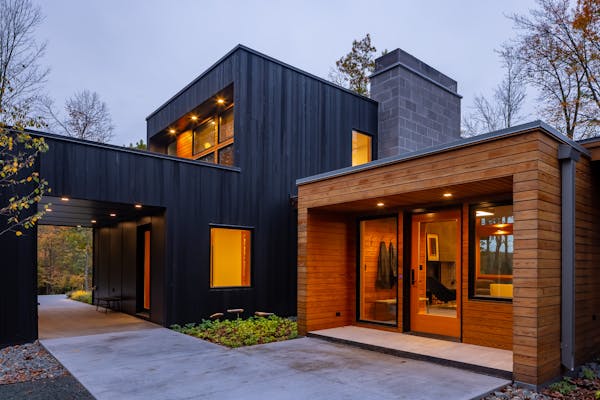A beloved activity for many boaters is checking out homes along the shore and picking their favorites.
Melissa Martyr and Sean Wagner, sailing enthusiasts and owners of NewStudio Architecture, are among them. The couple sailed White Bear Lake for years and agreed: The best house on the lake was a pink boathouse on Manitou Island.
"It's one of the last boathouses on White Bear Lake, and we fell in love with it," said Martyr.
Unlike larger bodies of water like Lake Minnetonka, which is home to many elaborate boathouses, some of which are architectural gems, those on White Bear Lake tended to be smaller and more utilitarian in design: basic concrete block garages for modest-sized boats.
As boats got bigger and people started using lifts, many of the boathouses were torn down. White Bear Lake was also once home to several boat builders (the last of them, Johnson Boat Works, was sold in 1998) where residents could store boats, further decreasing the need for boathouses on the lake, Wagner said.
The wife-husband team believe that the pink boathouse survived because it had been in the same family since 1947 and included a rare second-level living space that, according to the previous owner, had always been a popular spot for cocktails and card games.
"When setback limits passed [in the city] in the 1970s, it became that much more precious," Wagner said.
Someday came fast
Martyr and Wagner discussed reaching out to the owners someday to see if they would ever sell, maybe after their two teenage kids were out of college. But then they heard through the grapevine that the owners were getting ready to list the property, which included the boathouse as well as a primary house. The timing wasn't great for Martyr and Wagner, but they didn't want to miss the opportunity.
"We jumped on it," said Wagner.
They ended up tearing down the primary house (which had design and structural issues) to build a new home in its place. But first, they set out to restore the 525-square-foot boathouse, built in 1949.
Martyr and Wagner wanted to preserve the design and vintage details of the timeworn but structurally sound boathouse. Their goal was a refresh, not a rewrite.
"Erasing what was there was never part of the plan," said Martyr.
The second level came with a fully equipped entertaining space, comprising a kitchen, bathroom and living area cantilevered over the beach and surrounded by wraparound screens to capture views and breezes. The couple restored as much as possible, including the 1950s-era appliances — a stainless steel Thermador oven and cooktop.
Now rewired and polished, they gleam like chrome on a classic car, set off by aqua Formica countertops and the original steel kitchen cabinets. And what looks like a wide brick fireplace is actually a fully functioning indoor grill with two grates and a copper commercial-grade vent hood.
"You can cook fish on one side and hot dogs on the other," said Wagner.
The boathouse had a few functional issues that needed to be addressed, including the reworking of plumbing for a shower that drained directly into the lake. Interchangeable screen and storm windows were added, to extend enjoyment of the space into cooler months, when the boathouse becomes a warming house for winter lake activities.
Hold the kitsch
In addition to updating and preserving the place, the couple added some of their own design details.
White Bear Lake has a strong sailing tradition and an active yacht club that's been around since the late 1800s. Martyr and Wagner wanted to honor that history and their passion for the sport by incorporating sailing into the architecture and finishes.
Highlights include roller shades made from recycled sails, boat cleats to secure shade cords, wallboards from a 1970s wooden E Scow built by Johnson Boat Works and a sail the couple use as a wall hanging that honors Gordon Bowers, a local sailing legend. Martyr and Wagner recently hosted a gathering for a national regatta and enjoyed seeing attendees spot the references.
The pink exterior was given a makeover, now a subtler palette of gray and natural cedar. The couple salvaged and refinished the exterior boards from the boathouse and used them to clad the kitchen island.
Wagner has a theory about how the boathouse ended up pink.
"The original siding was old-growth redwood harvested in the 1940s," he said, "which has a pinkish/reddish tone. Maybe when that faded, someone decided to pink it up again, with paint."
These days, the family enjoys spending time in the updated boathouse they once admired from afar.
Martyr and Wagner have an open-door policy for friends and neighbors and take their stewardship of the property to heart. Cocktails and card games continue at the boathouse, carrying on a decades-long tradition.
"We're part of a story that precedes us and will continue after us," said Wagner. "Hopefully, we've done something that carries on the legacy of this place."


